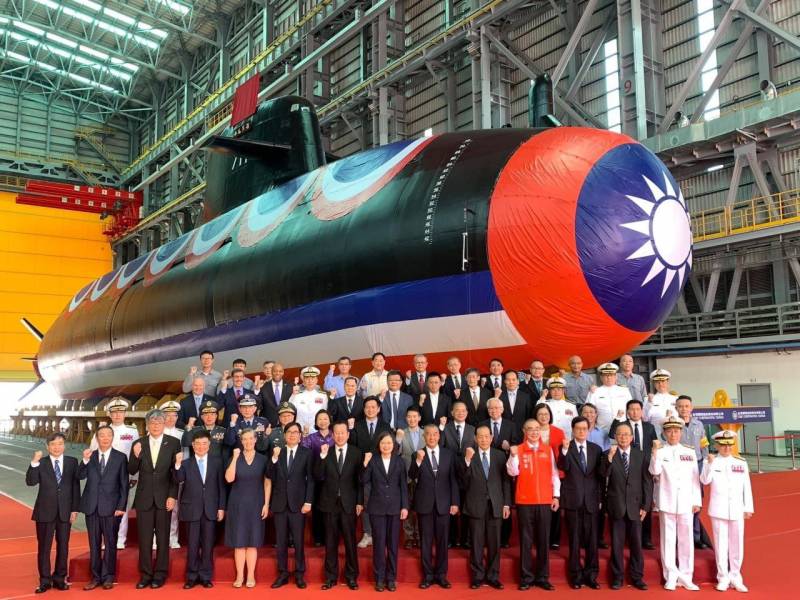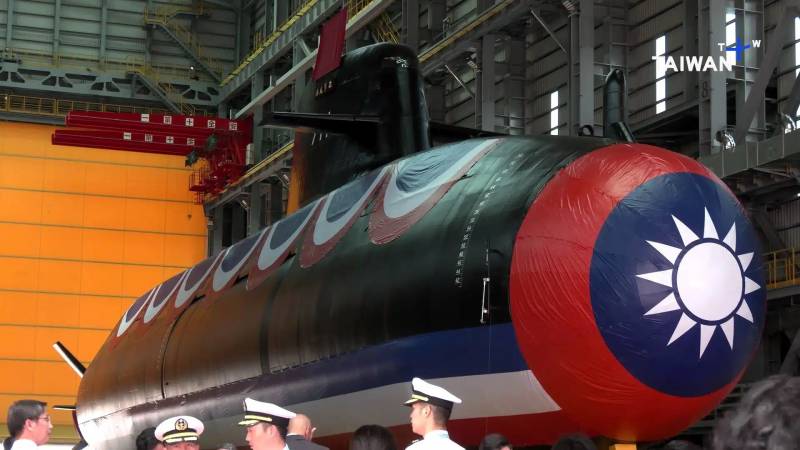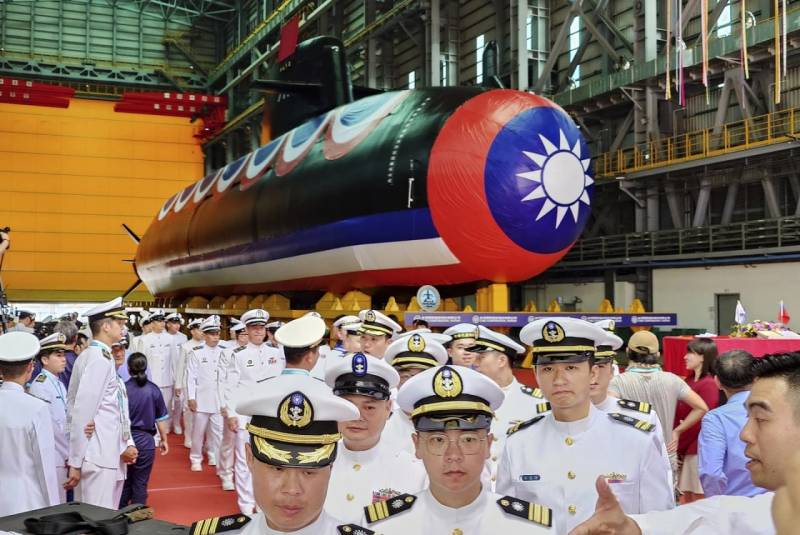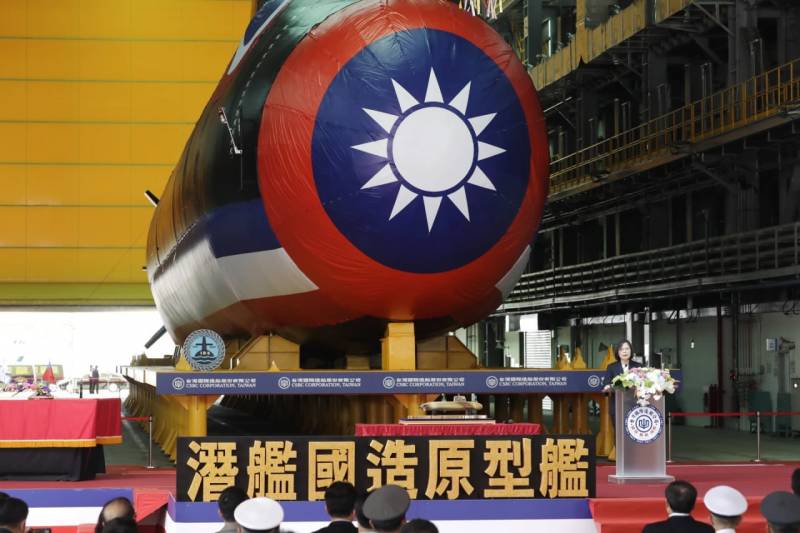Taiwan built its first submarine

Submarine SS 711 "Haikong", military and political leadership of Taiwan
The naval forces of the partially recognized Republic of China (Taiwan) have few and outdated submarines. fleet. In order to radically update it, its own project of a diesel-electric submarine was developed, according to which it is planned to build several ships. The lead diesel-electric submarine of a new type called “Haikun” was recently completed and removed from the boathouse.
Deprecation issues
Currently, the Taiwanese Navy has only four submarines. Two of them were received several decades ago from the United States. These are diesel-electric submarines of the American Tench and Balao projects, built in the mid-forties and later repeatedly modernized. In 1987-88 The fleet accepted two previously ordered Hai Lung submarines, built in the Netherlands according to the Zwaardvis project.
At the turn of the century, the Taiwanese authorities decided to modernize the submarine force through the purchase of modern foreign equipment. However, the search for a supplier did not lead to anything. Thus, the United States expressed its readiness to help, but could not build the required ships - they had long ago stopped producing diesel-electric submarines. Third countries, in turn, offered only outdated submarines that did not suit Taiwan. The search for a profitable offer continued for several years and was stopped.
The need to build submarines was again remembered only in the mid-2014s. In XNUMX, the Taiwanese Ministry of Defense announced that it plans to develop its own diesel-electric submarine project and build several pennants based on it. Soon the necessary preparatory work and design began, which took several years.
Own project
In 2016, as part of the long-term development program of the Navy, the Taiwanese military launched the IDS (Indigenous Defense Submarine) program. Its goal was to create a new diesel-electric submarine project with the required characteristics and the subsequent construction of eight ships. Due to this, in the long term they were going to improve the quantitative and qualitative indicators of the submarine forces and the fleet as a whole.
The order for the development and implementation of the project was received by the Zhongshan Institute of Science and Technology (CSIST) and the shipbuilding corporation CSBC. Also in 2016, the corporation formed a special design bureau, and in March 2017 signed a cooperation agreement with the Institute. Joint work on the project was planned to be completed in 2020.

The nose of the submarine with torpedo tube covers was covered with a cover in the colors of the national flag
The project was not created without foreign assistance. Thus, it is assumed that the Taiwanese IDS project was carried out on the basis of the Dutch Zwaardvis / “Hailong”. In addition, at the level of rumors, the involvement of British, Japanese and other foreign shipbuilding specialists in the project is mentioned.
At the same time, cooperation with some countries was carried out openly and officially. In 2018 and 2020 The United States approved the transfer of a number of necessary components, technologies and weapons to Taiwan. During the same period, similar agreements with the UK emerged, but their details remain unknown.
Various facilities of the CSBC Corporation were considered as a site for future construction, but in the end it was decided to build a new production complex. The Haichang Building site in Kaohsiung was founded in 2018 and put into operation in November 2020. Construction was carried out at the expense of the state.
Head ship
The first materials on the IDS project were shown in mid-2019. Subsequently, mock-ups of the promising submarine and other promotional materials regularly appeared at exhibitions. At the same time, the appearance of diesel-electric submarines was constantly adjusted in one way or another. In fact, its final version appeared only at the time of laying the head hull.
The laying of the first IDS submarine took place at the Haichang Building plant in November 2021. According to the approved schedule, construction was supposed to last less than two years. They plan to spend about two more years on testing and bringing the ship to full operation. Like the development of the project, construction was carried out in an atmosphere of secrecy, and its progress was not disclosed.
On September 28, a solemn ceremony of “baptism” and launching of the new submarine took place at the CSBC plant. Due to its high importance, the event was attended by the highest military and political leadership of the Republic of China. The lead IDS submarine, in compliance with all rituals, was taken out of the boathouse and placed in a floating dock, where mooring and hydraulic tests have been carried out since October 1.

In official publications, the new diesel-electric submarine is shown only from one side
The first pennant of the IDS type was named “Hai Kung” and tactical number SS 711. The name of the ship was taken from the ancient Chinese collection of parables “Zhuang Tzu” - in one of his stories this was the name of a giant fish. In addition, the word “narwhal” is written in the same characters in Chinese, and in some English-language publications “Haikun” is translated this way.
Plans for the future
On October 1, hydraulic and mooring tests of the new submarine began. According to the announced schedule, the preliminary testing stage and various events will continue at least until March next year. After this, the ship will have to go to sea. Delivery to the customer and commissioning into the Navy are planned for 2025, but so far no date has been specified.
Preparations are already underway for the construction of the second diesel-electric submarine of the IDS type. The name and hull number of the ship are still unknown. Also, the dates of laying and expected delivery to the customer are not reported. CSBC is probably now preparing to cut metal and/or lay down the next hull - the slipway and boathouse for it have recently become vacant.
In total, the Republic of China plans to build eight new submarines. It is unknown how long it will take to implement these plans. It can be assumed that due to limited production capabilities and other difficulties, the last ships of the series will begin service only in the thirties.
Technical features
Detailed technical information about the IDS project has not yet been officially disclosed. There are only fragmentary information of various kinds, estimates, etc. At the same time, it is possible to draw up an approximate appearance of the new submarine and understand its potential.
It is assumed that the Taiwanese IDS project was created on the basis of the Dutch Zwaardvis, and the main solutions and some of the designs were borrowed from it. In addition, this approach could lead to similar dimensions and displacement. In this regard, there is a widespread version about the use of a one-and-a-half-frame scheme in the IDS project. The length of the submarine can reach 70 m, the total displacement is approx. 2500 t.

The submarine is equipped with a diesel-electric power plant. According to unconfirmed reports, it contains American-made diesel and electric engines. For energy storage, rechargeable batteries of Taiwanese design and production are used. Lithium-ion batteries are probably used to improve performance. Propulsion - one propeller or water jet. Driving characteristics are unknown.
Key diesel-electric submarine systems were received from the USA. Thus, the automated combat control system was provided by Lockheed Martin, and the sonar system was ordered from Raytheon / RTX. Several other radio, navigation and other systems were supplied by L3Harris.
The submarine has bow torpedo tubes of 533 mm caliber. The number of pipes is not known, but at a recent ceremony the nose of the body with the covers of the apparatus was closed. Main weapons The new diesel-electric submarine will be American Mk 48 Mod 6AT torpedoes - Taiwan previously acquired a large batch of such products for use on existing and future submarines. Also, UGM-84L Harpoon Block II anti-ship missiles can be launched through the torpedo tube.
The praying mantis and the chariot
The IDS project and the Haikong submarine are of some interest, but mainly as an example of the determination and willingness of Taiwanese industry to develop new directions. Otherwise, the newly unveiled ship looks quite modest, and its prospects are, at best, ambiguous.
In general, the IDS project is similar to some foreign diesel-electric submarines, but only of fairly old types. Whether such a submarine can compare with modern models of its class is a big question. The possible potential and achievable performance of this boat is limited by several factors. First of all, this is a general lack of experience in the design and construction of such complex orders.
In particular, this was manifested in the appearance of the Haikun - in the photo from a recent ceremony numerous wrinkles are visible on the hull and deckhouse plating. Perhaps this indicates a low production culture. In addition, such an appearance may indicate the lack of a complete sound-absorbing coating, for example, due to the lack of necessary materials and technologies. In this case, the technical and combat characteristics of the ship should have suffered.

The exact composition of equipment and weapons is unknown, but foreign systems give the Taiwanese Navy some reason for optimism. To what extent their potential has been realized is unknown. At the same time, the weapons complex includes modern torpedoes and anti-ship missiles with fairly high tactical and technical characteristics.
Thus, the diesel-electric submarine SS 711 “Haikun”, like the IDS project as a whole, still looks very modest. Perhaps, as construction continues, measures will be taken to improve the boat, but a radical increase in characteristics and capabilities cannot be expected. However, if we take into account the current state of Taiwan’s submarine forces, even such new items will be useful.
It should be recalled that the entire military policy of the Republic of China is based on confrontation with the PRC. Taiwan expects an attack from mainland China and is preparing in every possible way to repel it - incl. by building new submarines. However, even after the completion of the entire IDS series, the balance of power will be far from in favor of Taiwan, both in quantitative and qualitative terms.
News about the first Taiwanese diesel-electric submarine caused an interesting reaction from the Chinese Ministry of Defense. The official representative of the department freely quoted the book “Zhuang Tzu”, from which the name for the submarine was taken, and compared Taiwan to a praying mantis trying to stop a chariot.
First try
Thus, despite all the restrictions and difficulties, the partially recognized Republic of China is trying to build its naval forces and prepare them for confrontation with the PRC. The next step in this direction was the development of our own design for a diesel-electric submarine and the construction of the lead ship. In the future, seven more corps will follow the Haikun, and this will lead to a radical improvement in the situation in the Taiwanese submarine fleet.
However, the first attempt to build our own submarine, as often happens when developing new directions, gave limited results. The Taiwanese Navy will now be able to receive a new combat unit, but one cannot count on high combat effectiveness and the ability to fully compete with the PLA submarine forces. It is not yet clear how this problem will be solved.
Information